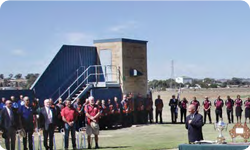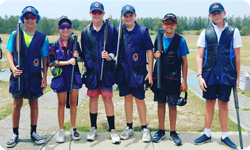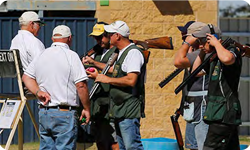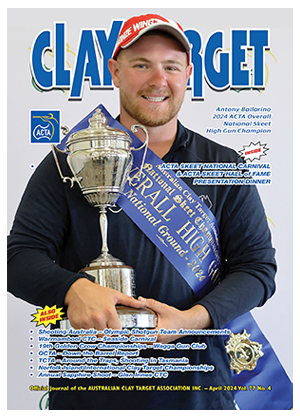|
Birth year:
|
1878 |
ACTA Club:
|
|
Preferred Discipline:
|
|
Age Started Clay Target Shooting:
|
|
Years Clay Target Shooting:
|
|
| Shooting Achievements: |
Year inducted into the ACTA Hall of Fame: 2011
John William Sutherland (known as Jack Calrossie) Born 4 April 1878 and Died 9 January 1968, aged 89 years.
John was the last child to be born at Old Square House, Wallan. It is fair to say that John became the most famous and widely known Sutherland, although few realise John Sutherland and 'Calrossie' were the same person. Way back in 1889, an enthusiastic schoolboy in the Katandra district was in the habit of accompanying his teacher, Don McLean on rabbit and hare shooting expeditions. He helped carry home his bag and catch as his teacher only had one arm. As John got older, he used to shoot birds and rabbits in the bush as he went to and from school. John's cousin, James of Broadford, is believed to have given John his first gun. John grew up in an atmosphere of gunpowder, his family were all excellent and keen rifle shooters. John won his first award, his Marksmanship Badge at the age of 16 or 17. In 1895 he made his first appearance in a pidgeon match at Shepparton. We will let 'Cal' as he is affectionately known, to tell the story in his own words:
"It was the first time I ever saw a bird liberated from the traps, and although considered a good field shot for a youngster, trapshooting was, of course, something quite new to me. Like all beginners I very soon discovered there was very much to learn. Being a country lad, and unaware of the existence of smokeless cartridges (home loaded), and although I shot my bird it was the last black powder cartridge I ever used over the traps. Never shall I forget that roar of laughter from the onlookers. It was even greater than the cloud of smoke from my carefully loaded cartridges. The secretary of the club, Mr A Halpin, supplied me with some of the smokeless variety, but I failed to get beyond four rounds and was a very interested spectator for the remainder of the match. The next match in which I competed was at Cosgrove, this time with both barrels charged with smokeless cartridges, but again failed, and it was not until my fifth attempt that my name figured as a prizewinner. By this time I had gleaned a few points, one in particular, that the old gun was no good for trapshooting. Fortunately the following year I was enabled to have the use of a high class hammerless gun, and in the next three matches success was the result. Incidentally, I won enough to purchase a gun of my own". He won his first championship in 1901 at Kerang and his last live bird shoot was in 1958 at the age of 80 years, after which live trap shooting was discontinued.
John's early life was spent with his older brother George, helping to manage the local general store at Katandra. James was also the local mailman for Katandra and Rockville to Cosgrove. In those days there were no made roads, only a bush track through timber. They were too muddy in winter for any cart and horse, so the best alternative was by horseback. John mainly collected and delivered letters, there were few newspapers in those days. His trips were eagerly awaited by the locals as letters were the only means of communication between families and friends, the telephone had still to make its arrival in the area. John appears to have commenced his mail run about 1896 and continued until he left Katandra about 1905.
His brother George enlisted for the Boer War, so the store was closed. John moved on to manage the creamery at Katandra for his brother Angus. In 1905, he became manager of the Calrossie Butter Factory, about six miles form Yarram in Gippsland. Living and working on the Calrossie Estate were many men called Jack or John and so as to distinguish one from the other, they acquired nicknames like "Long Jack" and "Tall Jack". John became known as "Calrossie Jack", and it was from this nickname that his anonymity in the field of shooting came from. John like his father and brothers had a great love of shooting. John especially excelling at the sport. It was not surprising that he applied for a job with Kynochs, which entailed a practical use of guns and ammunition for field and trap shooting. He commenced work at Kynochs (later known as ICI) in 1907.
John eventually became a winner of over 100 live trap shooting championships in Australia. His record of live bird kills without a miss has not been broken. In 1928 he went on a world tour shooting, at the home of trap shooting in Monte Carlo, there he created a world record of 128 birds straight in one shoot. John won the aggregate for the season at Monte Carlo, he also on the same tour won championships in England, France and Italy. Following his tour he reached his peak during the 1930's until the outbreak of war. In 1928 John was described by John Melan, an international shooting critic as "positively the best shot on the planet".
John always shot under the anonymous name 'Calrossie'. He was a man with a great sense of humour and enjoyed the anonymity the name gave him. He often remarked that on long country train journeys he would discuss Calrossie's shooting performances with various passengers. John enjoyed telling them he knew a chap called Jack Sutherland that could shoot as well as Calrossie, a lengthy argument often followed these discussions.
He was a modest champion who during his 50 years of world wide success described his greatest moment being when as a small boy, he shot his first running hare. John's characteristic of steady hand, cool nerve and accurate eye made him Australia's master shot. He was described as being a legend in his own lifetime.
Shooting he once remarked, "it was as natural to me as swimming is to a fish. It's a matter of judgement, good eyesight, steady nerves and practice, but I suppose I must have a flair to get to the top". It came as a surprise when they learned he wore spectacles in his office, only to discard them to shoot. In 1948 at 70 years of age he emerged from his sixth retirement to win his 104th championship and his second Commonwealth Galah Championship. John had stopped shooting for seven years and practised only a few times in the 12 months prior to his performance.
John had a great interest in champions and championships of billiards and snooker, although not a competitor himself. He was also a keen follower of shield and test cricket.
John married Isabelle English at Caulfield on October 23, 1912 and they lived their married life at Calrossie, 8 Malane St, Ormond. They had three sons, Leslie, Donald and Keith. Following the death of his wife in 1942, John married May McLean of Youanmite. John died at the age of 89 years. His death ended the life of the "Lindrum of the gun shot". John's name has become a world wide legend in the field of shooting.
|
John William 'Calrossie' Sutherland
Year Inducted: 2011
John William Sutherland (known as Jack Calrossie) Born 4 April 1878 and Died 9 January 1968, aged 89 years.
John was the last child to be born at Old Square House, Wallan. It is fair to say that John became the most famous and widely known Sutherland, although few realise John Sutherland and 'Calrossie' were the same person. Way back in 1889, an enthusiastic schoolboy in the Katandra district was in the habit of accompanying his teacher, Don McLean on rabbit and hare shooting expeditions. He helped carry home his bag and catch as his teacher only had one arm. As John got older, he used to shoot birds and rabbits in the bush as he went to and from school. John's cousin, James of Broadford, is believed to have given John his first gun. John grew up in an atmosphere of gunpowder, his family were all excellent and keen rifle shooters. John won his first award, his Marksmanship Badge at the age of 16 or 17. In 1895 he made his first appearance in a pidgeon match at Shepparton. We will let 'Cal' as he is affectionately known, to tell the story in his own words:
"It was the first time I ever saw a bird liberated from the traps, and although considered a good field shot for a youngster, trapshooting was, of course, something quite new to me. Like all beginners I very soon discovered there was very much to learn. Being a country lad, and unaware of the existence of smokeless cartridges (home loaded), and although I shot my bird it was the last black powder cartridge I ever used over the traps. Never shall I forget that roar of laughter from the onlookers. It was even greater than the cloud of smoke from my carefully loaded cartridges. The secretary of the club, Mr A Halpin, supplied me with some of the smokeless variety, but I failed to get beyond four rounds and was a very interested spectator for the remainder of the match. The next match in which I competed was at Cosgrove, this time with both barrels charged with smokeless cartridges, but again failed, and it was not until my fifth attempt that my name figured as a prizewinner. By this time I had gleaned a few points, one in particular, that the old gun was no good for trapshooting. Fortunately the following year I was enabled to have the use of a high class hammerless gun, and in the next three matches success was the result. Incidentally, I won enough to purchase a gun of my own". He won his first championship in 1901 at Kerang and his last live bird shoot was in 1958 at the age of 80 years, after which live trap shooting was discontinued.
John's early life was spent with his older brother George, helping to manage the local general store at Katandra. James was also the local mailman for Katandra and Rockville to Cosgrove. In those days there were no made roads, only a bush track through timber. They were too muddy in winter for any cart and horse, so the best alternative was by horseback. John mainly collected and delivered letters, there were few newspapers in those days. His trips were eagerly awaited by the locals as letters were the only means of communication between families and friends, the telephone had still to make its arrival in the area. John appears to have commenced his mail run about 1896 and continued until he left Katandra about 1905.
His brother George enlisted for the Boer War, so the store was closed. John moved on to manage the creamery at Katandra for his brother Angus. In 1905, he became manager of the Calrossie Butter Factory, about six miles form Yarram in Gippsland. Living and working on the Calrossie Estate were many men called Jack or John and so as to distinguish one from the other, they acquired nicknames like "Long Jack" and "Tall Jack". John became known as "Calrossie Jack", and it was from this nickname that his anonymity in the field of shooting came from. John like his father and brothers had a great love of shooting. John especially excelling at the sport. It was not surprising that he applied for a job with Kynochs, which entailed a practical use of guns and ammunition for field and trap shooting. He commenced work at Kynochs (later known as ICI) in 1907.
John eventually became a winner of over 100 live trap shooting championships in Australia. His record of live bird kills without a miss has not been broken. In 1928 he went on a world tour shooting, at the home of trap shooting in Monte Carlo, there he created a world record of 128 birds straight in one shoot. John won the aggregate for the season at Monte Carlo, he also on the same tour won championships in England, France and Italy. Following his tour he reached his peak during the 1930's until the outbreak of war. In 1928 John was described by John Melan, an international shooting critic as "positively the best shot on the planet".
John always shot under the anonymous name 'Calrossie'. He was a man with a great sense of humour and enjoyed the anonymity the name gave him. He often remarked that on long country train journeys he would discuss Calrossie's shooting performances with various passengers. John enjoyed telling them he knew a chap called Jack Sutherland that could shoot as well as Calrossie, a lengthy argument often followed these discussions.
He was a modest champion who during his 50 years of world wide success described his greatest moment being when as a small boy, he shot his first running hare. John's characteristic of steady hand, cool nerve and accurate eye made him Australia's master shot. He was described as being a legend in his own lifetime.
Shooting he once remarked, "it was as natural to me as swimming is to a fish. It's a matter of judgement, good eyesight, steady nerves and practice, but I suppose I must have a flair to get to the top". It came as a surprise when they learned he wore spectacles in his office, only to discard them to shoot. In 1948 at 70 years of age he emerged from his sixth retirement to win his 104th championship and his second Commonwealth Galah Championship. John had stopped shooting for seven years and practised only a few times in the 12 months prior to his performance.
John had a great interest in champions and championships of billiards and snooker, although not a competitor himself. He was also a keen follower of shield and test cricket.
John married Isabelle English at Caulfield on October 23, 1912 and they lived their married life at Calrossie, 8 Malane St, Ormond. They had three sons, Leslie, Donald and Keith. Following the death of his wife in 1942, John married May McLean of Youanmite. John died at the age of 89 years. His death ended the life of the "Lindrum of the gun shot". John's name has become a world wide legend in the field of shooting.
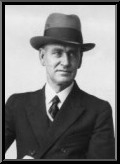 John William Sutherland (known as Jack Calrossie) Born 4 April 1878 and Died 9 January 1968, aged 89 years.
John William Sutherland (known as Jack Calrossie) Born 4 April 1878 and Died 9 January 1968, aged 89 years. 



